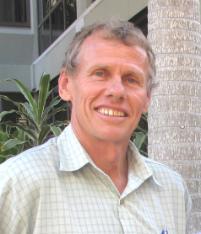CQ summers can be killers, says exercise and sports specialist
Published on 06 December, 2010
Central Queensland summers can be killers!
Being active in hot and/or humid conditions can lead to dehydration, heat illness and sometimes the more serious consequence of heat stroke.
CQUniversity Exercise and Sports Scientist and masters triathlete, Associate Professor Peter Reaburn says that while physical activity is important for overall health, in the hotter and humid months we need to take greater precautions to avoid heat injuries.

Associate Professor Peter Reaburn
"Dehydration and heat illness are serious matters for both exercisers and workers during the summer period. While people need to be active regularly to stay healthy or earn a living, they should take precautions if exercising in a hot environment, especially if the conditions are still and humid," said Associate Professor Reaburn, author of The Masters Athlete.
The Masters Athlete has just gone into a second reprint. Meanwhile, scientific publishing house CRC Press has contracted Peter to edit a new book titled Nutrition and performance in masters athletes. Peter says he has pulled together a 'dream team' of the world's leading researchers as contributors.
"High air temperatures, high humidity, still conditions, the wrong clothing, age, lack of fitness and working, training, or competing hard when dehydrated is a worry. Children are at a greater risk as their bodies respond less efficiently to heat and have greater difficulty getting rid of heat from their body.
"People should also know the symptoms of heat illness. These include thirst, light-headedness, nausea, headache, confusion, not sweating, and irrational behaviour.
"Knowing how to prevent heat illness and what to look out for will help to avoid it," said Associate Professor Reaburn.
Associate Professor Reaburn offers the following summer safety tips to avoid heat injuries:
- Stay hydrated by drinking water before, during and after exercise and work.
- Ensure your urine is close to clear as a sign of being adequately hydrated.
- Schedule training or exercise in the early mornings or late afternoons to avoid the hottest part of the day.
- Walk, run or cycle into the wind on the way home to stay cooler
- Take rest breaks in a shady and windy spot if needed.
- Wear light coloured, lightweight, loose fitting clothing made of natural fibres like cotton that allows easy evaporation of sweat from the skin.
- Wear sunglasses, 30+ sunscreen and a porous hat and carry water or sports drinks with you when exercising.
- Reduce the duration and intensity of a warm-up to minimise an increase in body temperature.
- Do not train, compete or do strenuous activity if you have recently experienced a high temperature, infection, diarrhoea or vomiting.
- If you have a medical condition such as asthma, diabetes, a heart problem, epilepsy or obesity, are taking medication, or are pregnant; you may experience difficulties exercising in the heat. If unsure you should seek advice from a sports medicine professional.
- Persons suffering from heat illness can recover rapidly with assistance - laying down in a cool and windy place, removing excess clothing, wetting the skin or using ice packs in the groin, round the neck or under the arms, and drinking cool water. However if symptoms do not improve, seek medical assistance.
For further advice visit www.sma.org.au . Masters Athlete is available via ... www.mastersathlete.com.au/masters-athlete-book/ .

